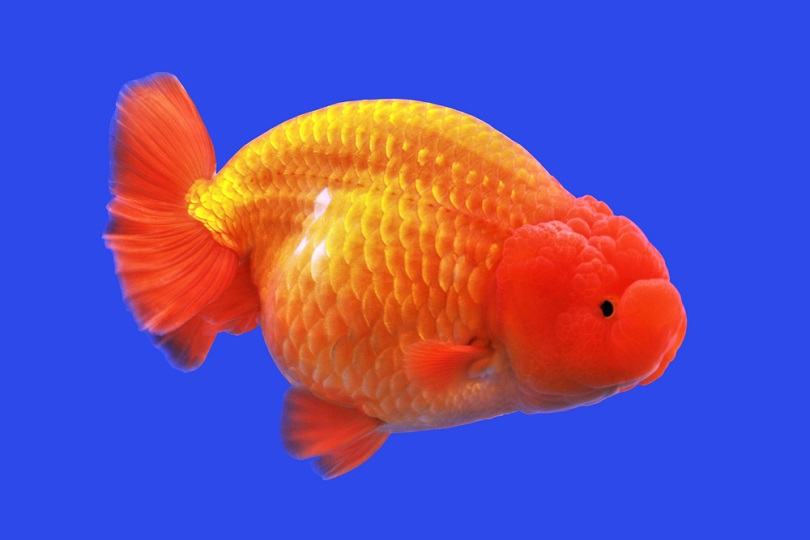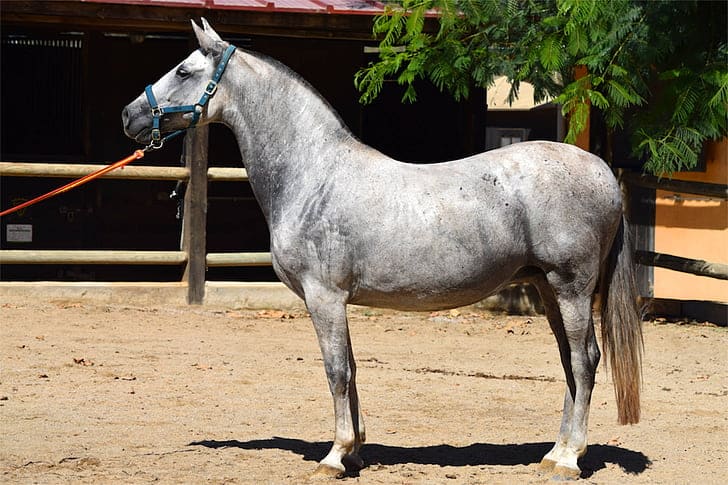Easy to care for and unique in appearance, the lionhead goldfish is a great addition to any freshwater aquarium. These fish mature to around 8 inches and have raised scales and a fantail that set them apart from other goldfish. They’re herbivorous fish with minimal maintenance needs, though they do require a tank with plenty of filtration because they produce a lot of bioload.
Let’s take a closer look at a few of this variety’s specific traits so you can see how they might fit into your aquarium.

Quick Facts About Lionhead Goldfish
| Species Name: | Carassius auratus |
| Family: | Asian carp |
| Care Level: | Moderate |
| Temperature: | 65–75ºF |
| Temperament: | Peaceful |
| Color Form: | Varies |
| Lifespan: | 15 years |
| Size: | 5–8 inches |
| Diet: | Omnivore |
| Minimum Tank Size: | 20 gallons |
| Tank Set-Up: | 6.5–7.5 pH and 4–20 KH |
| Compatibility: | Other peaceful fish |
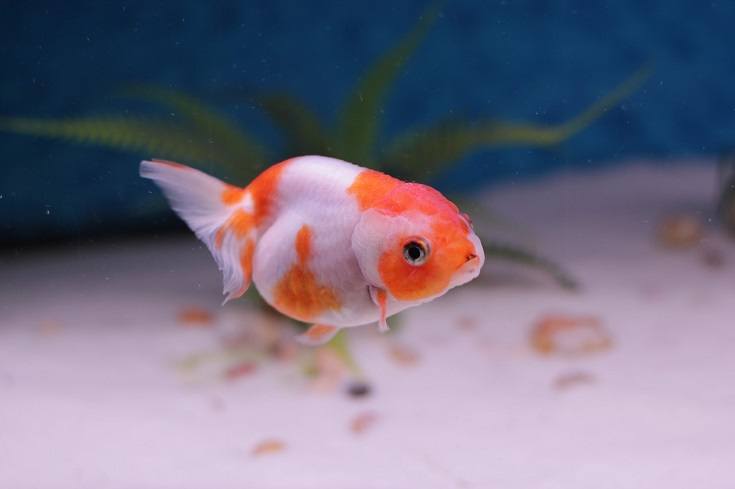
Lionhead Goldfish Overview
When it comes to goldfish without a dorsal fin, the lionhead goldfish is the most popular by a long shot. They’re one of the most well-known goldfish, and you’ll find them in many aquariums across the world.
These goldfish don’t exist naturally; they were specifically created to achieve particular traits. They’re actually a species of Asian carp and can even survive in minimally brackish water. They tend to get along with most community fish that aren’t aggressive since they’re herbivores themselves. This includes other fish like pencil fish, mollies, and smaller tetras. However, they also seem to do just as well as solo fish and don’t require the company of other fish to be healthy and happy.
The lionhead goldfish was created in China, though they quickly spread throughout the world, gaining popularity as an aquarium fish thanks to their interesting shape and appearance. They’re considered to be tranquil and peaceful fish with graceful movements and an overall beauty that have helped them gain popularity so quickly. Even during mating season, they’re not known to display aggressive tendencies.
Don’t expect to see your lionhead goldfish zip around the aquarium. They’re notoriously slow swimmers, thanks in part to the lack of any stabilizing dorsal fin. They’re also known to have poor eyesight, which often results in them being quite clumsy.
How Much Do Lionhead Goldfish Cost?
The price of lionhead goldfish can vary dramatically, depending on where you purchase one. They’re also quite a bit pricier than any standard-variety goldfish. You can generally pick up a common goldfish for between a few cents and a few bucks. But lionhead goldfish cost several times as much.
You should expect to spend $15–$30 on your lionhead goldfish. Note that this doesn’t include the cost of a tank and all the necessary accessories.
Typical Behavior & Temperament
Lionhead goldfish are considered community fish and are known to be peaceful. They get along great with any other peaceful community fish, so they’ll likely do well being added to your current aquarium with whatever fish are harmoniously existing there now.
But they also do great as the only fish in a habitat and don’t require a community. They tend to be very slow, and many think of them as lazy. In truth, they’re just poor swimmers, so they don’t move around much.
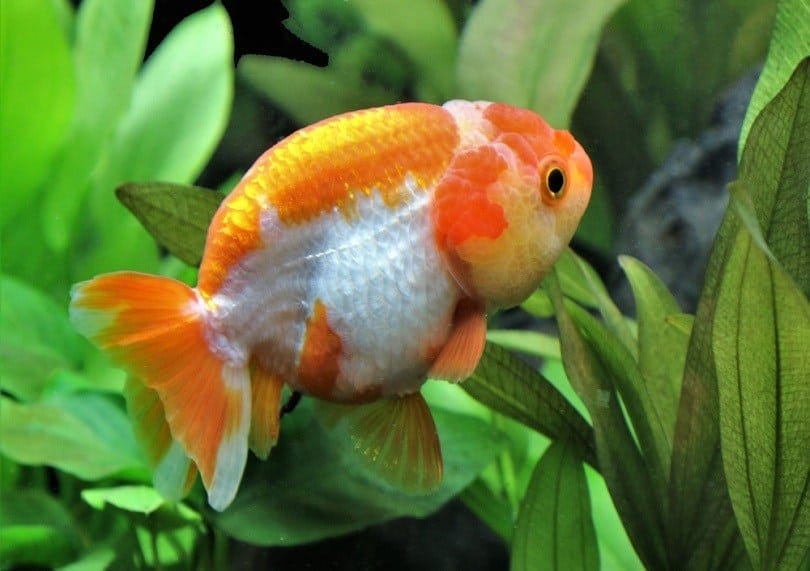
Appearance & Varieties
A lionhead goldfish look quite different from a common goldfish due to their round, egg-shaped body and the complete lack of a stabilizing dorsal fin. These fish are considered fancy goldfish and were specifically bred to create the “hood” on their head. This hood is meant to mimic a Chinese lion dog, a special ornament often found in Chinese architecture.
That hood is called a wen, and it’s a growth that can get so large that it covers the fish’s face. This can even start to block their vision, resulting in a poor swimming fish that can’t see well. The wen isn’t smooth though. It’s a bumpy growth with a texture similar to that of a raspberry.
Lionhead goldfish come in a wide variety of colors. The most common is a mix of red, orange, and white, but they can also be found in blue, black, calico, and combinations of these colors.
Often, this fish is mistaken for an oranda goldfish. These fish do look similar, but it’s easy to tell them apart because lionhead goldfish lack a dorsal fin while an oranda has one. But they share the same egg-shaped bodies, which is why they’re often mistaken for each other, though lionheads tend to be rounder than orandas.
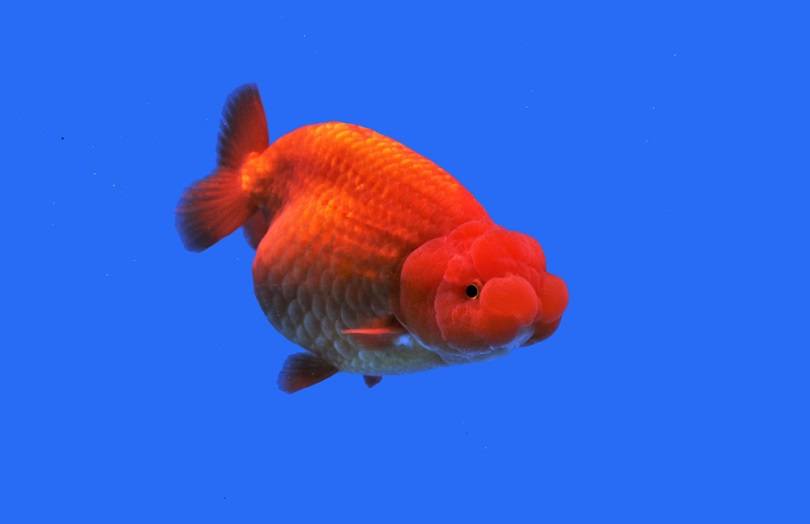
How to Take Care of Lionhead Goldfish
Habitat, Tank Conditions & Setup
Lionhead goldfish are pretty easy to care for and won’t require any special tank setups. Still, you’ll want to ensure that your aquarium is in the proper range to keep your fish in great health.
Tank Size
These fish tend to be about 8 inches long, but they can reach lengths of up to 10 inches. They will require an aquarium that’s 20 gallons at the minimum, though a larger space is always beneficial. But these requirements are for a single lionhead goldfish. Each additional fish requires 10 gallons more space. If you plan on housing a community, you’ll want a tank that’s at least 50 gallons.
Housing a goldfish isn't as simple as buying a bowl. If you're a new or experienced goldfish keeper who wants to get the setup right for your goldfish family, check out the best-selling book, The Truth About Goldfish, on Amazon.
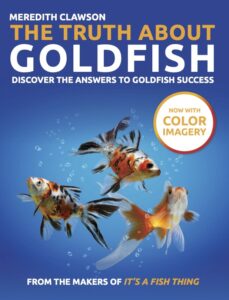
It covers all you need to know about the ideal tank setup, tank size, substrate, ornaments, plants, and so much more!
Water Temperature
Lionhead goldfish are not tropical, so they don’t need warm water, but they do have specific temperature requirements. You’ll want to keep the water between 65 and 75 degrees Fahrenheit, so you might need to use a small water heater.
pH Range
Like most goldfish, the lionhead has a limited pH range that they do well in. They can tolerate a pH level of 6.0–8.0. You won’t want the tank to get below a pH of 6 or above a pH of 8.
Substrate
Lionheads are not very durable fish. Their wens are susceptible to infection and injury, so you want to avoid anything sharp or abrasive. Many people who keep these fish keep the bottom of their tanks bare. But if you’re going to use a substrate, smooth stones or sand is the best choice.
Plants
You can keep some plants in the tank with a lionhead goldfish. They might nibble on them or dig them up, but the plants shouldn’t pose a danger. However, you’ll want to stay away from most other decorations like driftwood and rocks. These abrasive surfaces can potentially cause damage to your lionhead’s sensitive body.
Lighting
If you have plants in your lionhead’s aquarium, you’ll need to worry about lighting. But if you don’t, it won’t matter much. These fish do well in a brightly lit or dimly lit environment.
Filtration
These fish are highly susceptible to illness and infection, so you’ll need to keep their habitat pristinely clean. As such, you’ll need a powerful filter to ensure their water is always devoid of contaminants.
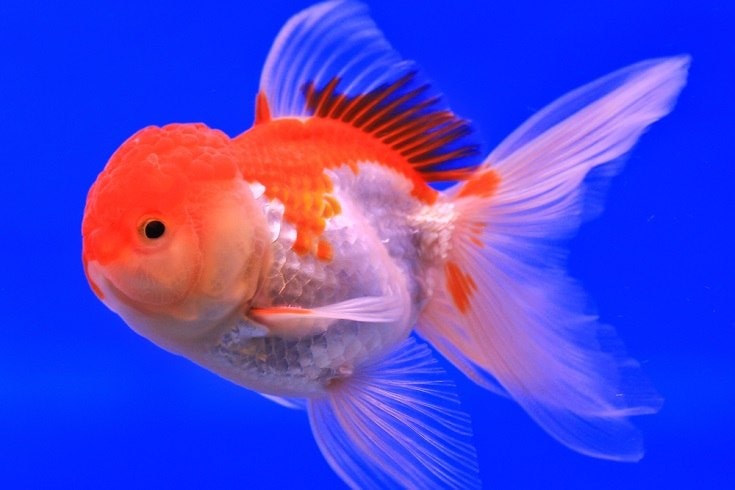
Are Lionhead Goldfish Good Tank Mates?
These fish make great tank mates for other peaceful community fish. They’re non-aggressive and tend to be gentle, so they can do well with other non-aggressive fish.
However, lionhead goldfish do poorly with fast-moving fish that might make them compete for food. Remember, lionheads are poor swimmers. They simply can’t keep up and won’t be able to feed. This means they won’t do well sharing a tank with many other goldfish, like common, comet, and shubunkin goldfish.
Since they’re slow and large, these fish also can’t defend themselves, so they should never be with fish that nip fins or show aggression. If your lionhead gets hurt, they’re more likely to get an infection than other breeds.
Instead, you should keep these fish in a tank with schooling fish or other slow swimmers. Bubble-eye goldfish make great companions, as do black moor and celestial goldfish. Minnows and danios are also good choices. You can even go with bottom feeders like loaches. Non-fish species like snails and shrimp are generally sound choices.
What to Feed Your Lionhead Goldfish
Since lionheads are omnivores, they eat a wide range of foods. However, these fish are known for their voracious appetites, so you’ll want to limit feeding to twice daily. Otherwise, your fish will likely overeat, which can lead to health problems.
These fish will eat certain proteins that come from live foods. These “meats” should only make up about half of your fish’s diet at most. Meat foods that your lionhead will eat include:
- Brine shrimp
- Bloodworms
- Tubifex worms
- Daphnia
While your lionhead will eat and enjoy these foods, they should also be eating many plant-based food sources. The other 50% or more of your lionhead’s diet should consist of foods like:
- Vegetables
- Plant matter
- Fish flakes
- Goldfish-specific feeding pellets
Remember, these fish are slow and clumsy and often don’t see well. They can’t compete for food, and with other fish sharing the same tank, they might need extra help when it comes to feeding time to make sure they’re getting their fair share.
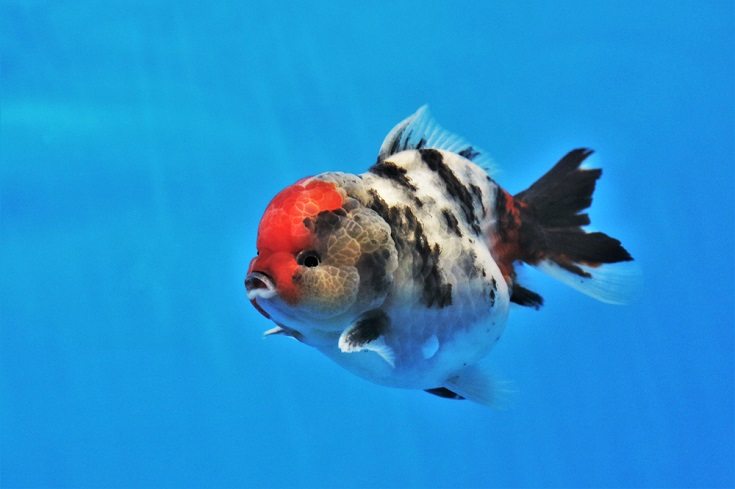
Keeping Your Lionhead Goldfish Healthy
Lionhead goldfish are far from a hardy fish species. They’re susceptible to a wide range of issues, and their facial growths pose a risk of their own. These fish are vulnerable to infections and can be injured easily. Poor water quality or tank hygiene can mean death for a lionhead goldfish, so you’ll need to keep your aquarium in top shape at all times.
These fish often develop bacterial infections such as fin rot, fish tuberculosis, or dropsy. All of these can become fatal quickly if not treated. You’ll also find that lionheads are susceptible to fungal infections like cotton wool fungus, which can permanently alter them.
Infections aren’t the only risks, though. You’ll also have to watch out for parasites and protozoa like flatworms, anchor worms, fish lice, ich, Chilodenella, and costia.
- Related Read: Do Goldfish Sleep?
Breeding
A lionhead goldfish lays a clutch of approximately 10,000 eggs. They can be bred in small groups with as few as five fish, though they also breed well in large groups. To induce mating, you’ll need to mimic natural conditions.
First, you’ll need healthy fish that are free of diseases or health problems. You might even want to treat them for parasites. Second, you should separate males and females to increase interest in spawning, introducing them to the breeding tank together.
To get them to start spawning, you’ll have to start slowly reducing tank temperatures until the water reaches about 60 degrees Fahrenheit. Once it reaches this temperature, you’ll then need to slowly warm the water by a few degrees each day until spawning begins, which is usually between 68 and 74 degrees.
Don’t worry when the males start chasing the females around the tank. It’s non-aggressive and may continue for several days while the colors of the fish get more intense. Soon, they’ll mate. Shortly after, the parents will begin eating the eggs, so you’ll want to separate them quickly. The eggs will hatch in less than a week.
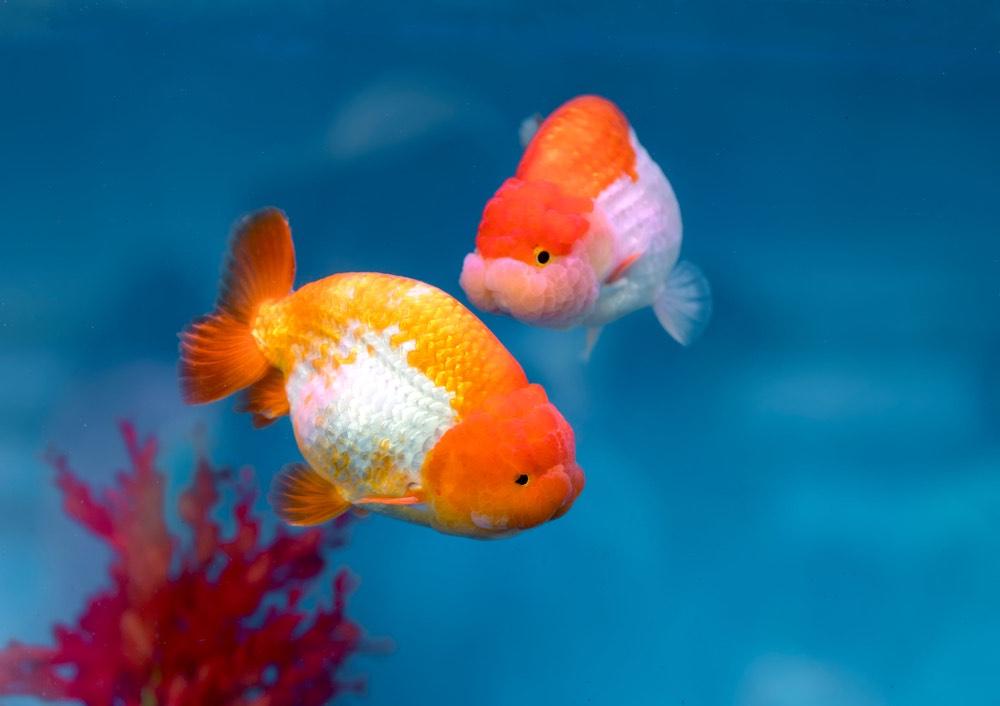

Are Lionhead Goldfish Suitable for Your Aquarium?
There’s no doubt that lionhead goldfish are unique, interesting, and in their own way, attractive. But are they right for your aquarium? It depends on what’s in your tank now. If you have many fast-moving fish or any aggressive residents, a lionhead goldfish won’t do well.
But if you have a colony of peaceful fish, they might fit right in. Just make sure you don’t have any rough or abrasive decorations in there that might cause injury. Lionhead goldfish aren’t that hardy and can be easily damaged on just about anything. Surround them with other slow-swimming fish that don’t compete for food, and they should do just fine.
- Related Read: Ranchu vs Lionhead Goldfish
Featured Image Credit: Arunee Rodloy, Shutterstock
